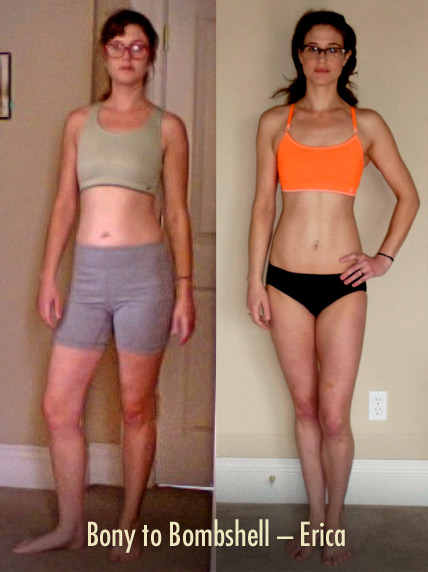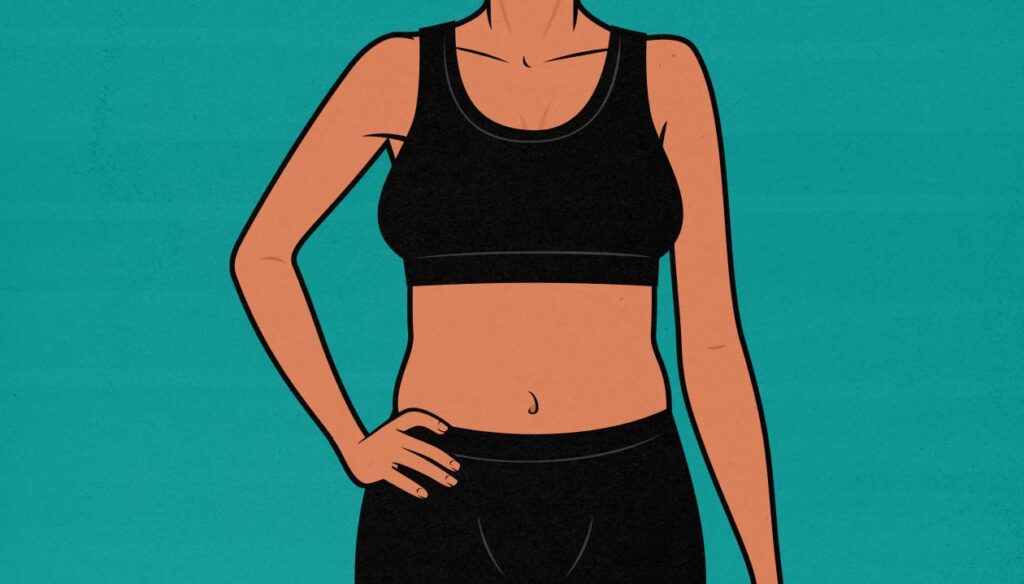
The Skinny-Fat Woman’s Diet & Workout Guide
How should skinny-fat women approach their diet, exercise, and lifestyle?
It’s a confusing situation because if you’re a skinny fat girl, it’s unclear whether you’ve been overeating or undereating. It’s hard to know whether you should be trying to gain weight to encourage muscle growth or trying to lose weight to burn fat. Inside this article, we’ll talk about what a skinny-fat female is and what some next steps could look like.
- What Is A Skinny-Fat Woman?
- How to Know If You’re Skinny-Fat
- Why Do Some Women Become Skinny-Fat?
- Skinny Fat Women & Hypertrophy Training
- The Skinny-Fat Woman’s Workout Routine
- The Skinny Fat Woman’s Diet
- Getting Enough Sleep
- Fixing A Skinny-Fat Lifestyle
- Eating the Right Amount of Food
- Summary For A Skinny-Fat Women’s Diet & Workout Plan
- What Next?
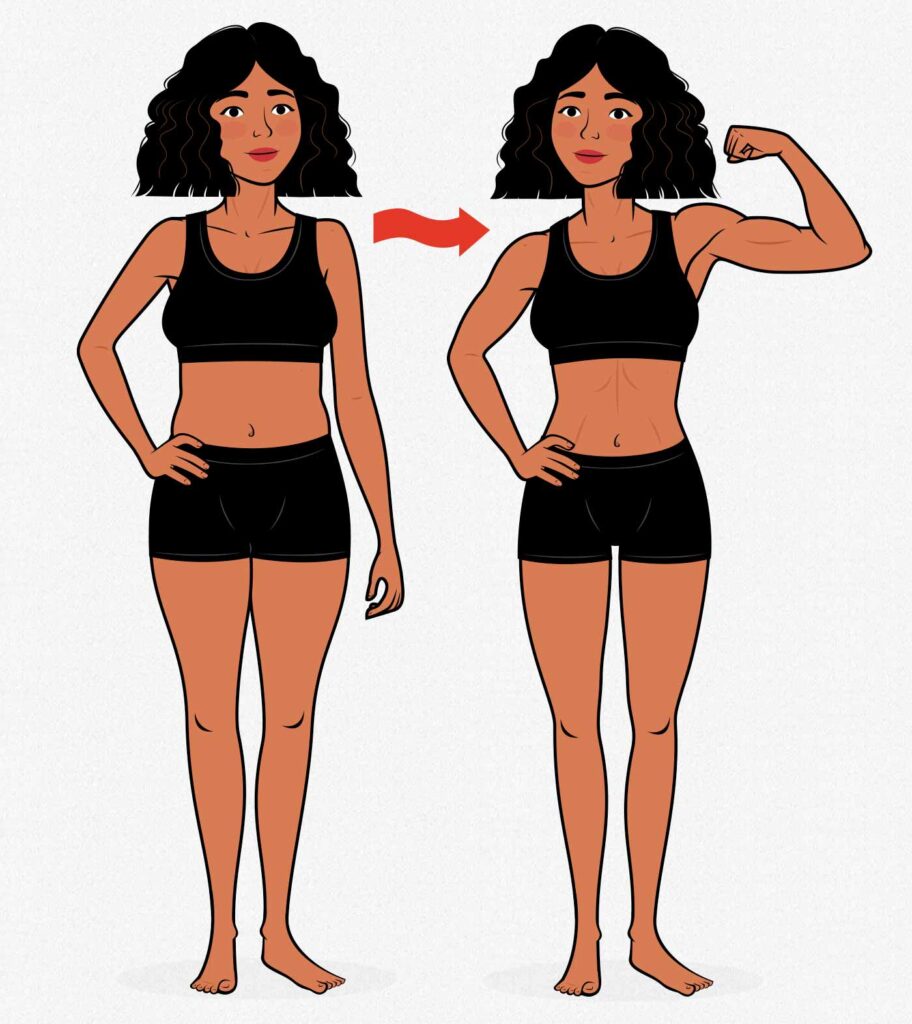
What Is A Skinny-Fat Woman?
A skinny-fat woman is when you have lower-than-average strength along with a higher body-fat percentage. For instance, maybe you’re at a healthy weight, but you can’t do a push-up or chin-up, and you’re worried you’ve got a flabby midsection or thighs.
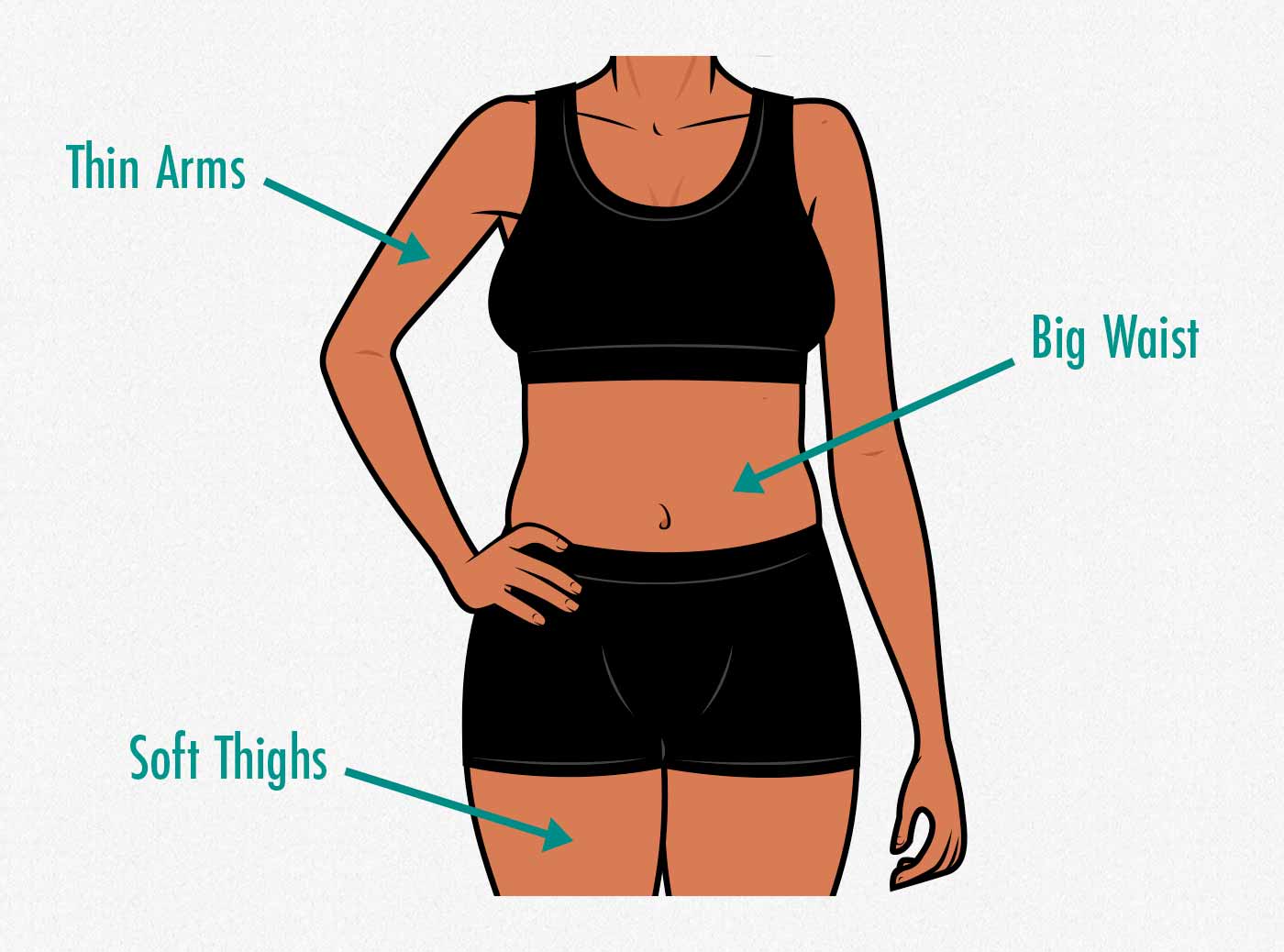
How to Know If You’re Skinny-Fat
Skinny-fat isn’t a formal word, and it doesn’t have a specific definition. Many different women refer to themselves as skinny-fat. In our experience, most women who call themselves skinny-fat are regular women with average bodies, perhaps on the thinner side, who aren’t following a good workout routine or eating a great diet.
It’s rare for women to call other women skinny-fat, but it’s common for people to describe themselves that way. And that’s fine sometimes. There’s nothing wrong with feeling out of shape or wanting to get both leaner and stronger. Those are both great goals. You may even be able to make progress towards both of them at once.
With all of that said, some women are a bit liberal with their use of the word “skinny-fat.” They might have a healthy body-fat percentage, they exercise regularly, eat good diets, and can bust out a few push-ups and a couple of chin-ups without a problem. They feel skinny-fat because they don’t look like the women they see on social media. And to be fair, most of the women on social media don’t look like they do on social media, either!
So the first thing to consider is whether a woman’s physique is out of shape or if someone just has high standards.
Why Do Some Women Become Skinny-Fat?
Most skinny-fat girls are simply out of shape. And to be fair, that describes the vast majority of people. Most people aren’t active, don’t eat good diets, don’t get enough sleep, and don’t lift weights at least twice per week. Most people also overeat and eat highly processed foods, causing them to become overweight over time.
But if you’re a woman with a thinner build or a smaller appetite, instead of becoming overweight, an unhealthy diet and lifestyle can make you skinny-fat.
So there are a few reasons you might be skinny-fat. Usually, it comes from a combination of factors:
- A lack of resistance training: if your muscles aren’t routinely challenged, they won’t grow. And as the years go by, they usually shrink. And because your body isn’t trying to maintain or build muscle, more calories you eat will be stored as fat.
- A lack of protein: the protein you eat is broken down into amino acids. These amino acids are used for various purposes, such as maintaining your nails, hair, and muscles. If you aren’t eating enough protein, there won’t be enough amino acids to maintain your muscle size. Because your body won’t be able to gain or maintain muscle, more of the calories you eat will be stored as fat.
- A lack of sleep: getting enough sleep is an important part of leading a healthy lifestyle. It improves your hormone profile, increases muscle growth, and reduces fat storage. But getting enough sleep can be hard, especially as a new parent. (As parents, we haven’t had a good week’s sleep in 3 years, and we only have one 3-year-old child!) Now, just to be clear: you can build muscle and lose fat even if you aren’t getting enough sleep. It’s just harder.
- A lack of exercise overall: even if you aren’t lifting weights, engaging in regular exercise tends to challenge your muscles at least a little bit, causing your body to maintain more muscle mass as you age. Regular exercise can also mitigate fat storage, especially visceral fat storage—the fat around your midsection. That’s why people who live active lifestyles are less likely to be skinny-fat, even if they don’t do any formal weight training.
- A bad diet overall: eating too many processed foods, too much alcohol, and not enough fruits, meats, and veggies can make things worse. Changing your diet is easier said than done, though.
It’s also worth pointing out that genetics and upbringing can play a role. The better someone’s genetics are, the worse their lifestyle will need to be before they start becoming skinny-fat. Similarly, women who grow up playing sports and eating good diets often have an easier time maintaining their strength, physiques, and habits as they age.
The main thing to keep in mind, though, is that skinny-fat isn’t a body type; it’s just what happens to almost everyone when they get out of shape. If you start following a lifting program for women focused on building muscle size, going on a daily walk, eating more protein, and trying to get to bed earlier, you’ll see your body begin to transform. Within a few months, you can go from skinny-fat to strong-fit. Check out how Erica did following the Bony to Bombshell program:
Skinny Fat Women & Hypertrophy Training
What Is Hypertrophy Training?
There are a few types of resistance training. Strength training is often rooted in powerlifting and is thus more focused on helping people lift more weight for a single repetition on the squat, bench press, and deadlift. Bodybuilding is often rooted in competitive physique sports. It often includes things like learning poses, dieting down to an extremely low body-fat percentage for a single day, spray tans, and the whole shebang. And callisthenics is often rooted in gymnastics, including athletic exercises like handstands and planches.
Hypertrophy training simply means “training to build muscle.” It’s ideal for gaining muscle mass and general strength. Like strength training, it focuses on getting stronger at the big compound lifts. Like bodybuilding, it includes isolation lifts for target muscle groups. And like callisthenics, it isn’t afraid to use bodyweight exercises, such as push-ups.
Most styles of resistance training will stimulate some muscle growth, but hypertrophy training is the easiest and most effective way to do it, and it has great carry-over into general health and fitness. If you’re a skinny-fat girl, it makes for the best default.
What Results Can You Expect From Your Workouts As A Skinny-Fat Woman?
Hypertrophy training is a way of telling your body that it should invest more of its energy into gaining muscle mass and strength. Once you start doing that, more of the calories you eat will be used to build muscle and fewer will be stored as body fat. Over time, you’ll grow stronger and leaner.

For example, in this study, the participants who ate a calorie deficit diet while doing cardio lost around 3/4 fat and 1/4 muscle. Those are great results, but if you’re already feeling skinny and small, the last thing you want to do is lose more muscle.
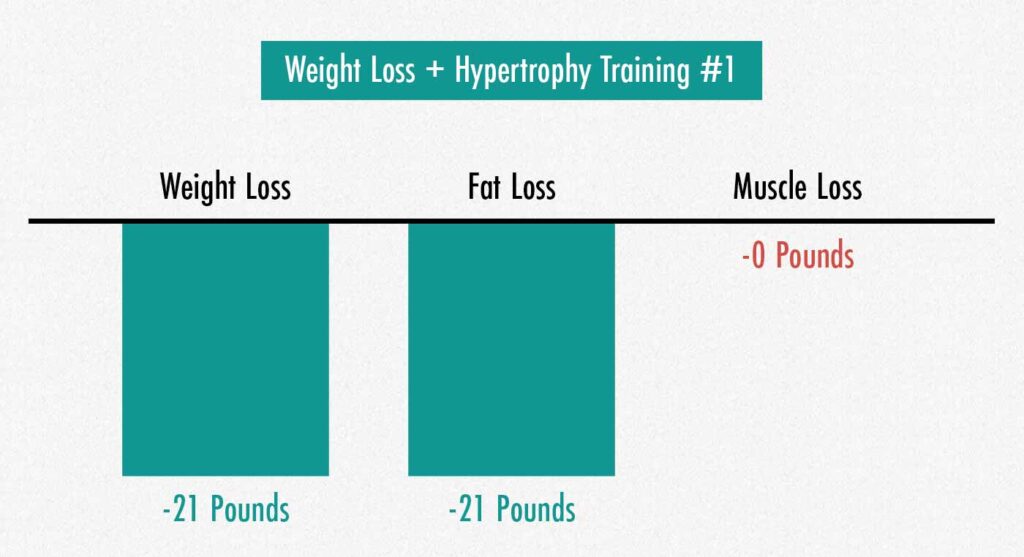
If you add in resistance training, like lifting weights, the muscle loss disappears. And since you’re still losing the same amount of overall weight, that means you’re losing fat even faster.

In fact, you may be able to do even better. In this study, the participants were able to gain 4 pounds of muscle while losing 22 pounds of fat. This is how you absolutely obliterate skinny-fatness. It will help you keep the strength you have (and even build new curves) while losing the fat that you don’t want.
The Principle of Progressive Overload
Hypertrophy training boils down to challenging your strength, eating enough food and protein to recover and grow, and then challenging your strength again. And since your muscles have grown back bigger, over time, you become more capable. So you try to lift more weight or eke out more repetitions. This is called progressive overload.
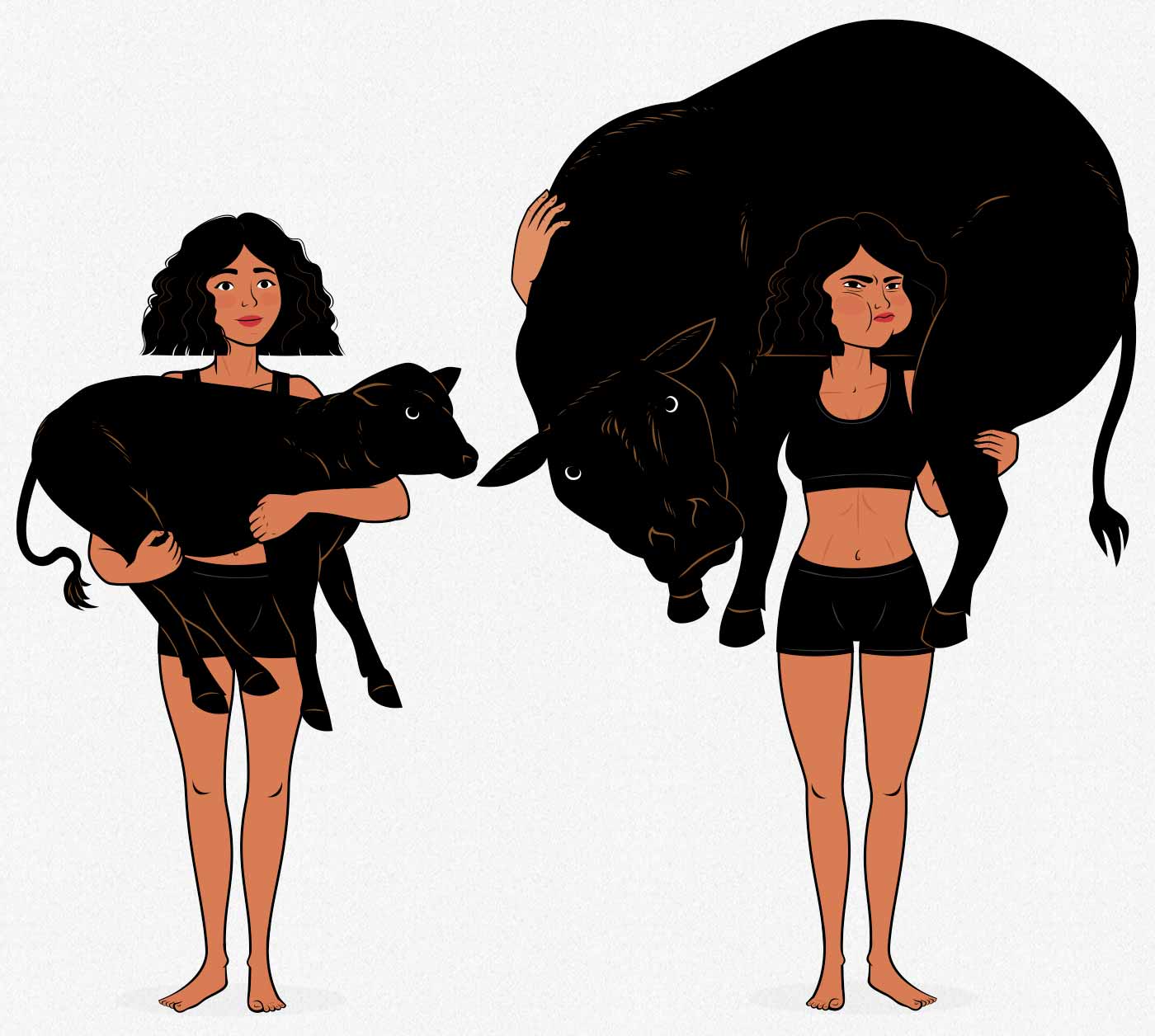
Think of the old myth of Mila of Croton. Mila was determined to be the strongest wrestler in Greece, so she started carrying a calf up a hill every morning. Over time, her muscles grew bigger, making her stronger. But the calf was also growing heavier, continuing to challenge her. By the time the calf grew into a bull, Mila wasn’t skinny-fat anymore. She had become a strength legend, not just in Greece, but also on Instagram. For more, we have a full article on how to use progressive overload to gain muscle size and strength.
What Equipment Do You Need?
You can train at a gym or at home. You can use barbells or dumbbells, or exercise machines, or a mix of all three. That way you can do simple muscle-building exercises and you can load them gradually heavier.
Your body doesn’t care if the weight comes from a barbell, a dumbbell, or a kettlebell. So there’s a lot of freedom when it comes to getting workout equipment. If you’re building your own home gym, here’s the equipment you need.
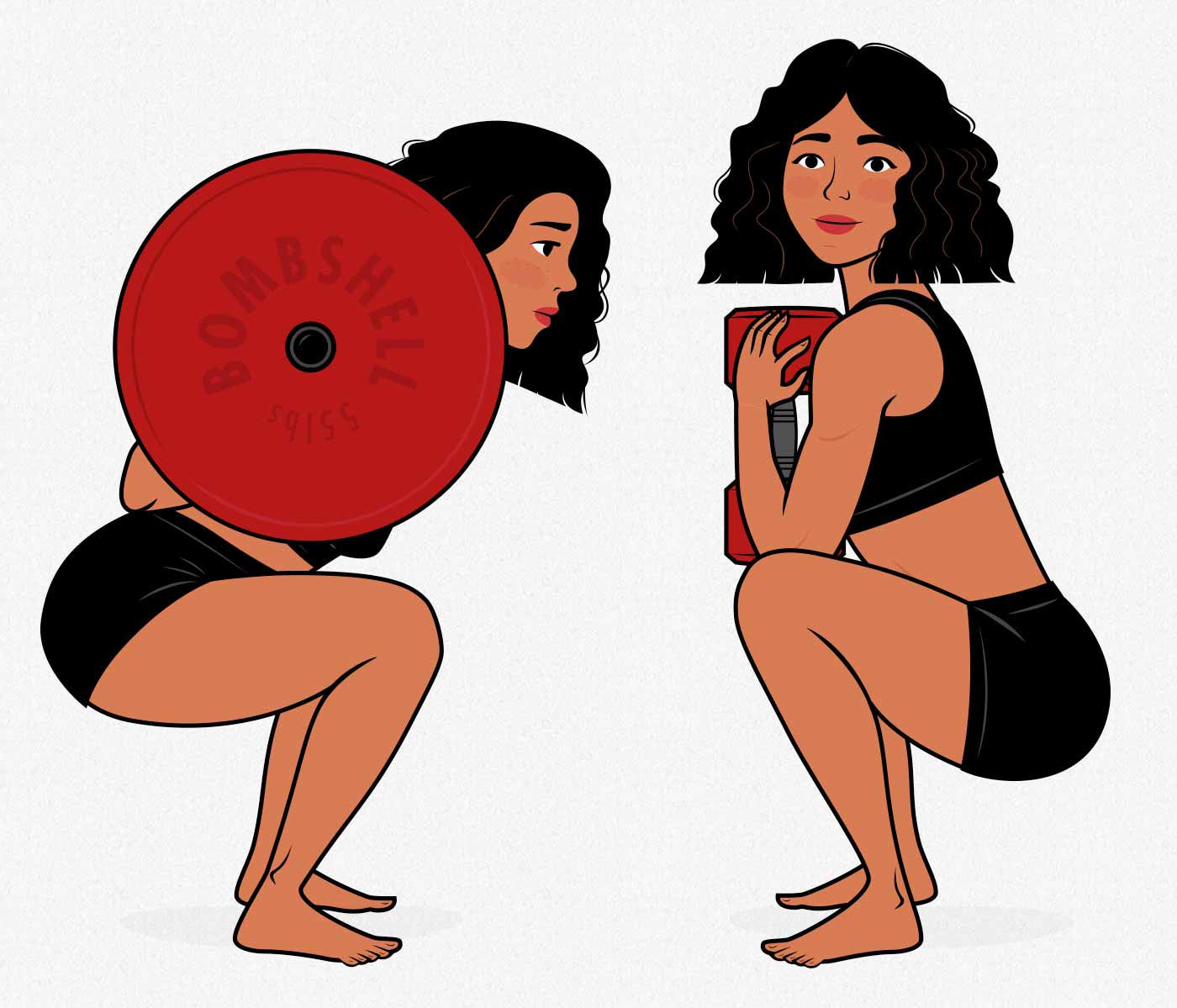
How to Structure Your Workouts
You can build muscle with both light and heavy weights. But to make it as easy as possible, choose an amount of weight you can lift for 6–20 repetitions. That’s light enough that you can get at least a few reps in, allowing you to do some solid work. And it’s heavy enough to develop muscular strength instead of endurance. If you do 2–4 sets per exercise per workout, that’s usually enough to stimulate a maximal amount of muscle growth.
A challenging workout can stimulate up to 2–3 days of muscle growth. To keep your muscles growing all week long, you’d train them every 2–3 days. For skinny-fat women we recommend starting with 3 full-body workouts each week. That will give you a good balance of stimulation (stress) and recovery (growth).
Finally, you have to train hard enough. If you’re focused on progressive overload, lifting more weight or doing more reps each workout, you’ll eventually get to the point where you’re pushing yourself extremely hard, fighting tooth and nail for progress. But if you want great results right out of the gate, make sure you’re taking your sets close to muscular failure.
If you aren’t sure how close to failure you’re lifting, try taking the set all the way to failure—to the point where your muscles don’t have the physical strength to keep going. Once you know what failure is, you’ll be better at stopping just shy of that point. If you fail at 6 push-ups, stop at 4–5. And then next workout, hopefully, you’ve grown stronger. Try to get an extra rep.
The Skinny-Fat Woman’s Workout Routine
Everyone is starting at a different level, so feel free to adjust the exercises to suit your strength, equipment, and experience level. But for a simple example, your hypertrophy training workout routine might look something like this:
- Goblet squats: 3 sets of 12 repetitions.
- Raised push-ups: 3 sets of as many push-ups as you can do (AMRAP)
- Romanian Deadlifts: 3 sets of 12 repetitions.
- One-Arm Dumbbell Rows: 3 sets of 12 repetitions.
- Bodyweight hip thrusts: 3 sets of as many reps as you can do. If you can do more than 20 reps, try doing single-leg hip thrusts.
Skinny Fat Woman Video Exercise Demonstrations
The Goblet Squat
Raised Push-Ups
Romanian Deadlifts
Dumbbell Rows
Hip Thrusts
For more, we have a full article on the best muscle-building exercises for women.
Free Women’s Full Body Workout Spreadsheet
GET THE GOOGLE SPREADSHEET OF THE
FREE female BEGINNER’S FULL-BODY WORKOUT
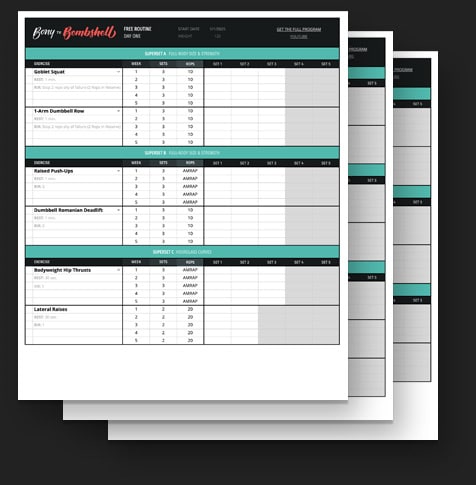
Get the workout as a Google spreadsheet. You’ll be able to pick from exercise alternatives, fill out the sheet, and get our beginner’s warm-up.
Plus, we’ll make sure you’re on the Bony to Bombshell newsletter, and send you all of our best women's muscle-building content.
Effort Matters For Muscle Growth
Take every set close to failure, and rest at least a minute between each set. Every workout, try to improve in some way. Usually, that means adding more weight, getting more reps (in any of the sets), or using a deeper range of motion (such as squatting lower).
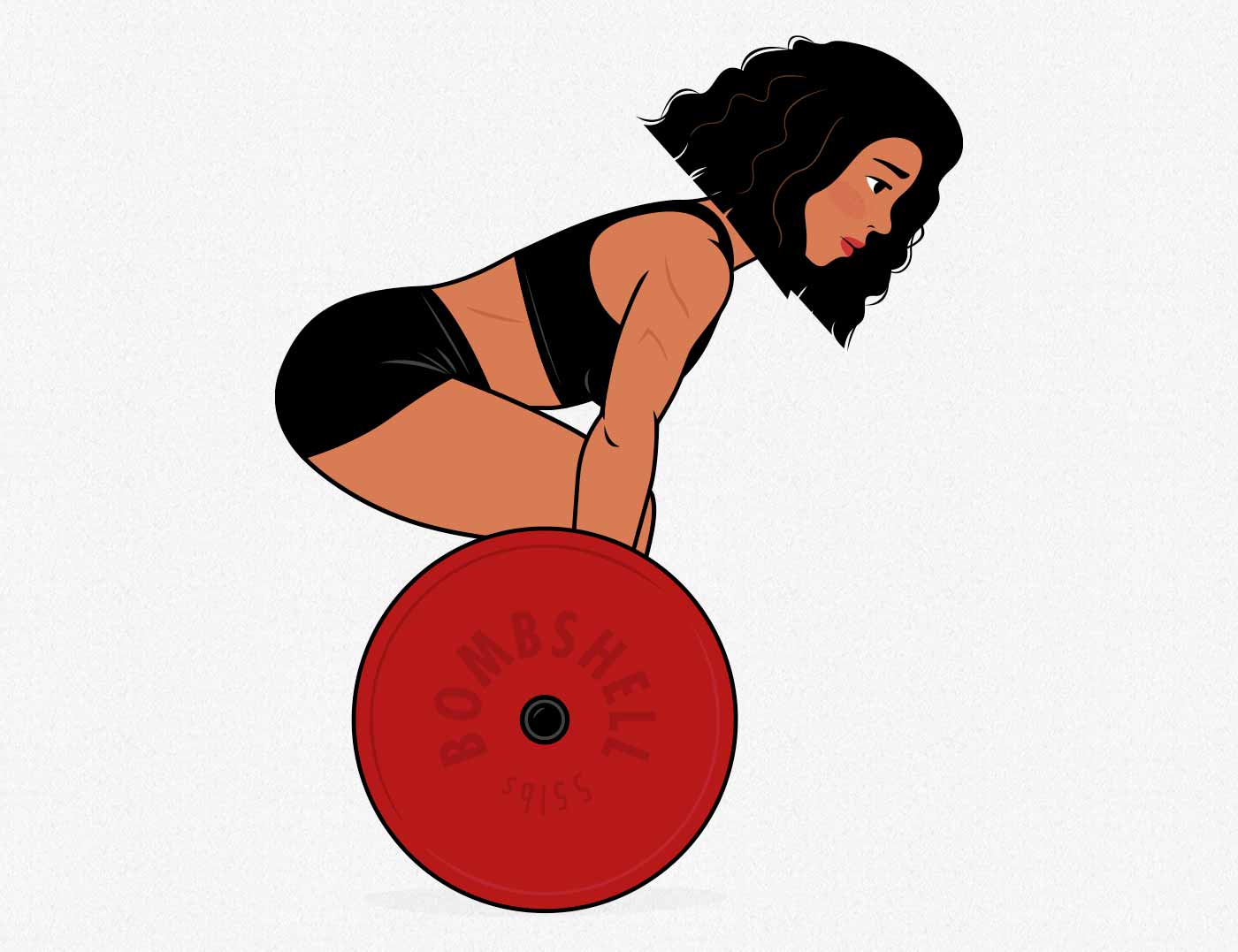
This workout stimulates all of the muscles in your body, putting a bit of extra emphasis on your glutes. You’d do this workout every Monday, Wednesday, and Friday, keeping all of your muscles growing all week long.
If you combine that workout with a typical weight-loss diet, you’ll probably lose fat while maintaining or gaining muscle. If you combine that workout with a high-protein muscle-building diet, you’ll minimize fat gain while building muscle at full speed.
As you get stronger and more experienced, you can switch to more advanced exercises and add in a wider variety of movements. Perhaps you switch from goblet squats to barbell back squats. Maybe you add in some lateral raises for your shoulders, some planks for your abs and posture, or some biceps curls for your arms.
For more, we have a full beginner workout guide for women, including videos teaching all of the lifts, and an example of how to put the full workout routine together.
Start Now, Get Better Gradually
Starting a workout plan can seem overwhelming. It’s easy to put it off until you feel completely ready. But no matter how prepared you get, it will always be a little awkward at first. The best thing to do is just start. Maybe you aren’t doing the best exercises. Maybe you’re lifting with an awkward technique. But that’s okay. All you need to do is get gradually better.
That’s all there is to it. That’s the whole secret to gaining muscle and strength. You just need to focus on getting a little bit better every workout. And remember, we have a simple beginner workout guide you can start with.
The Skinny Fat Woman’s Diet
How Important is Protein?
To reiterate, the first thing to do is lift weights. It’s by far the most powerful way to build muscle and improve your body composition as a skinny-fat woman. Even if you don’t do anything else, weight training alone is probably enough to see dramatic changes in your body.
After you’ve started lifting weights, though, we can get you much better results by increasing your protein intake. You build muscle with the protein you eat, so once you’ve stimulated muscle growth with your workout, eating more protein will increase the amount of muscle you can build—at least to a point.
What Results Can You Expect from Eating Enough Protein?
In one study, the participants combined hypertrophy (muscle size) training with two different protein intakes. Half the participants ate 0.5 grams of protein per pound bodyweight per day. The other half ate a whole gram of protein per pound bodyweight. Twice as much. For a 130-pound woman, that’s 65 grams versus 130 grams of protein each day.
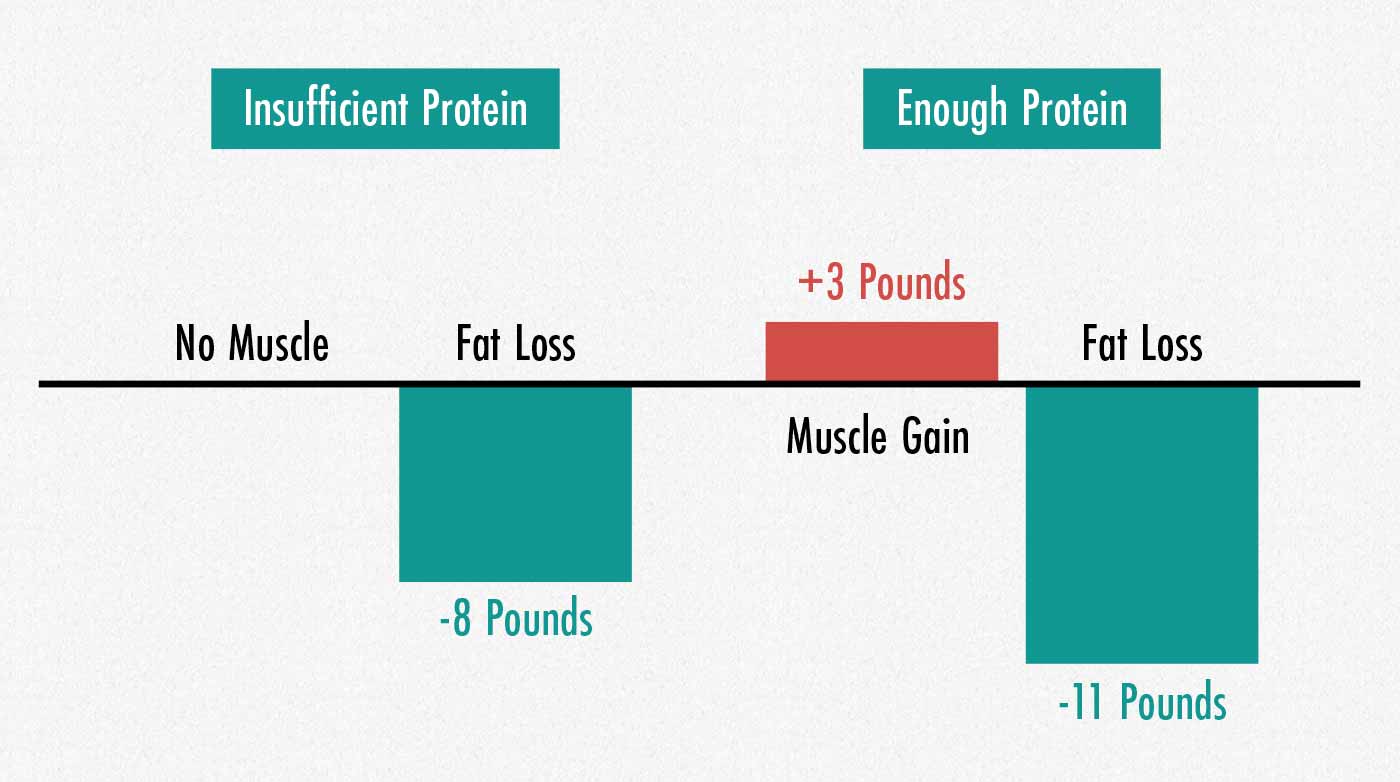
After four weeks, the group eating an average amount of protein lost 7.7 pounds of fat but failed to gain any muscle. And that’s pretty good! They lost almost two pounds of fat per week without losing any muscle! Hypertrophy training is fantastic.
If we look at the other group, though, the results are incredible! Not only did they lose nearly three pounds of fat per week, but they were also able to gain three pounds of muscle. The calorie deficit was the same, so both groups lost the same amount of weight, but the group eating enough protein did a much better job of getting the hell out of skinny-fat-ville.
How Much Protein Should You Eat?
Now, the next thing to keep in mind is that you can only build muscle so fast. Once you’re eating enough protein to fuel that muscle growth (and keep your hair and nails healthy), then eating extra protein won’t do anything more. That cut-off point is usually around 0.8–1 gram of protein per pound body weight per day. So for a skinny fat woman who weighs 130 pounds, she should aim to eat about 104–130 grams of protein per day. There’s nothing wrong with eating even more protein, but it won’t further improve your results.
What Are the Best Sources of Protein?
There are lots of great sources of protein.
- Lean cuts of meat like chicken, turkey breast, and red meat with the fat trimmed off
- Fish like tuna, white fish, and salmon
- Dairy like greek yogurt, cottage cheese
- Eggs
- Plant-based proteins like tofu or soy milk
- Protein powders like whey and soy isolate
- To a lesser extent, there is still some protein in:
- beans, lentils, chickpeas, peas, whole grains, regular yogurt, cheese, peanuts, and nuts

If you eat plenty of whole foods, you’ll probably be eating meat (or tofu), dairy (or soy), legumes, peas, nuts, and whole grains. Your diet will already be fairly rich in protein. You might not need to add anything else.
But if you’re struggling to get enough protein in, just buy a protein powder. It isn’t better than whole foods for building muscle, but it is more convenient. Whey protein makes for a great default, but plant-based protein powders are fantastic too, especially if you don’t do well with dairy. And if you like to add protein to oatmeal or baked goods, consider using casein protein powder.
If you eat a plant-based diet, we’ve got a full article on the best plant-based protein sources.
Here’s Randi losing 3 pounds in 5 weeks while lifting weights and eating a high-protein whole foods diet.
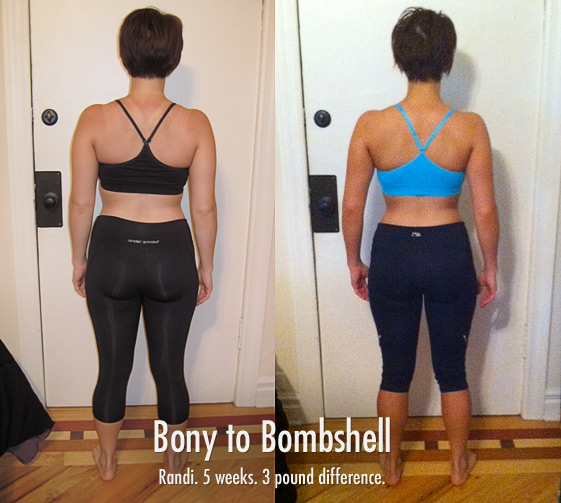
Getting Enough Sleep
How Important Is Sleep As A Skinny Fat Woman?
Okay, so you’ve started working out and eating more protein. You’ve stimulated muscle growth and given your body the materials it needs to build that muscle back bigger and stronger. That’s enough to start getting results, even if you aren’t sleeping well. After that, though, sleep is the next thing to focus on.
You build muscle all day long, but when you sleep, your body goes through a period of deeper recovery. Not only is this great for building muscle, but it’s also great for maintaining your general health, hormone production, and energy levels (study, study, study, study, study).
When you get enough sleep, you’ll find that you build more muscle, lose more fat, and have an easier time building healthy habits.
What Results Can You Expect From Getting Enough Sleep?
In this study, the researchers put all participants on a hypertrophy training program. Half continued on with their regular bedtime routines, and the other half were taught how to improve their sleep. Here’s what happened:
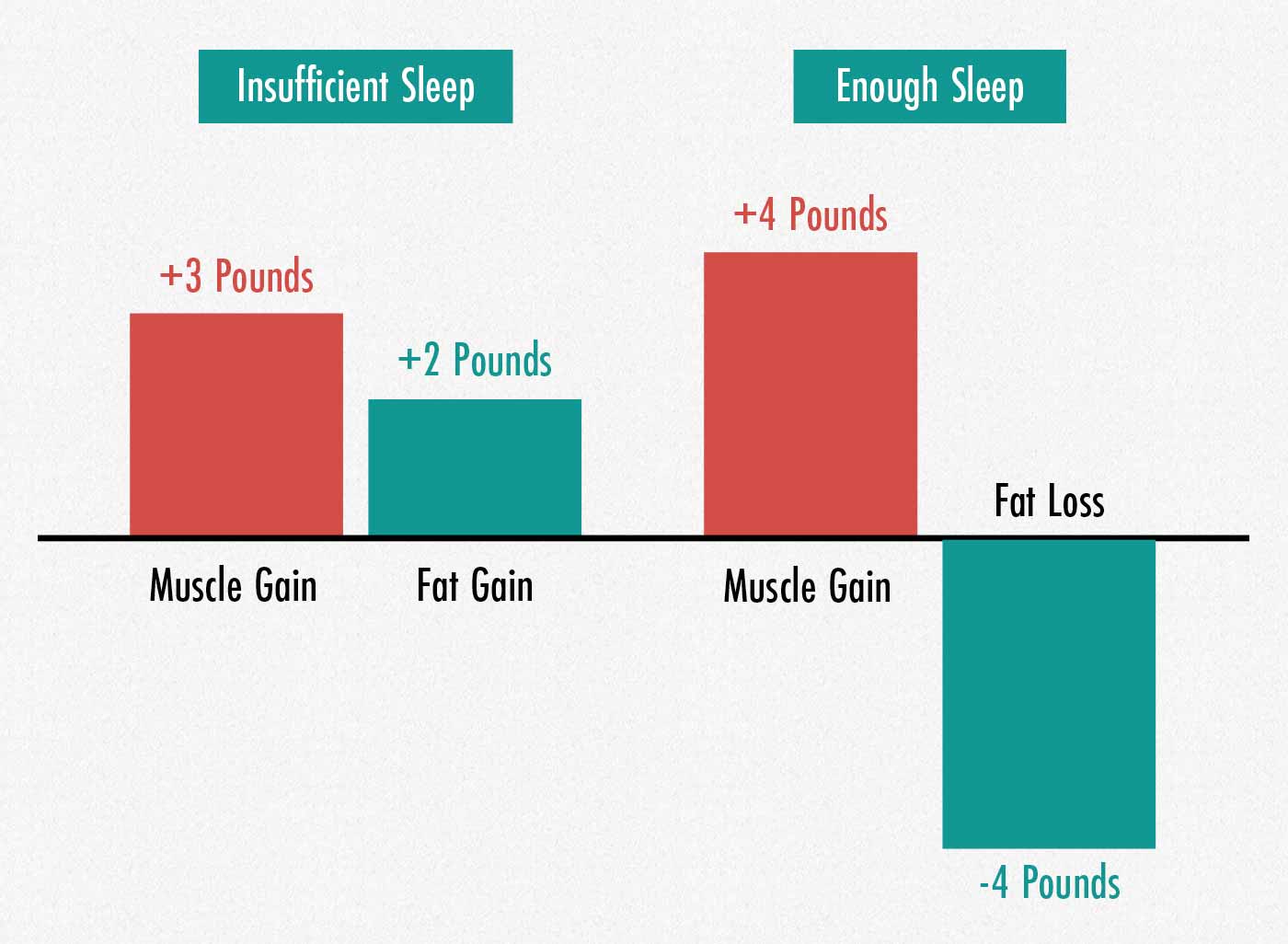
Both groups succeeded at building muscle. Hypertrophy training is extremely powerful.
But the group that improved their sleep gained 30% more muscle and lost four pounds of fat. Again, this is precisely the sort of intervention that can fix skinny-fatness.
How to Improve Your Sleep Habits
Improving your sleep isn’t rocket science. Sometimes all you need to do is gear down for bed a little earlier. Instead of watching that extra episode on TV, you head to bed a bit earlier. Maybe you tuck yourself into bed and read a relaxing book with a dimmer, yellower light.
But sometimes improving your sleep is hard. If you have irregular shifts at work or young children at home, getting a good night’s rest can be almost impossible. And if you’re stressed and anxious, you may find it hard to fall asleep. That’s when these sleep strategies become more important.
To improve your sleep, you need to:
- Sleep enough: 7–8 hours is enough for most people, and I recommend experimenting with the higher end. If you routinely wake up an hour early feeling refreshed, that’s a sign you may need less sleep.
- Sleep well: ideally, you want to fall asleep easily and then get a restful sleep without waking up too many times during the night. The most important factor is reducing your stress before bed, which can be done by relaxing away from screens, work, and notifications. For example, going into your study or bedroom an hour before bedtime to read a speculative fiction novel by dim lamplight.
There are quite a few strategies for improving your sleep, though, and we cover all of them in our article on improving sleep for muscle growth. And remember, even if your sleep isn’t perfect, you can still get great results. Improve your sleep if you can, even if those improvements are small. But don’t stress if you can’t.
Fixing A Skinny-Fat Lifestyle
Once you’re working out, eating enough protein, and getting enough sleep, you’re doing enough to get reliable results. Even combining just two of those interventions is usually enough to cause muscle gain and fat loss, especially in female beginners. By combining all three, you can expect even better results.
There are a few other things you can do to further improve your results, though, at least by a little bit:
- Eat mostly whole foods. You don’t need to be too strict with defining whole foods, but you probably know what we mean. Buy fewer packaged foods and less takeout. Buy more fruits, veggies, meat, fish, eggs, cheese, yoghurt, oats, nuts, legumes, and extra-virgin olive oil. That kind of thing. Pastuerized and homogenized milk, soy milk, tofu, polished grains, and whey protein are all processed foods. And that’s okay. Even white bread is fine, and so are desserts and treats in moderation. Just try to eat mostly unprocessed foods.
- Try to go on daily walks. Walking is an easy way to get some fresh air, burn some calories, get the blood flowing, and create some vitamin D from the sun. If you can, go on two 20-minute walks every day. One in the morning, the other in the evening. If you have a dog, great—they make excellent walking partners. In a pinch, spouses or children can make suitable walking partners as well.
- Keep your alcohol consumption under control. Most research shows that women are perfectly fine with one drink per day. There are no known downsides to health, muscle growth, or fat loss if you have just one drink per day (study). Even moderation deserves moderation. But try not to overdo it too often.
- Manage your stress. Getting enough exercise and sleep can improve your mood and reduce your stress, but these aren’t perfect solutions. Life can be stressful. Maybe it’s that stressful, busy lifestyle that made you skinny-fat in the first place. But if you notice that you’re always stressed or anxious, it can be worth trying to find a way to mitigate it.
Remember that you can get killer results without any of these finer details. Life is hard sometimes. You can’t always be perfect. Try to focus on the bigger picture. But the more of these habits you can implement, the smoother things will go.
Eating the Right Amount of Food
Skinny-Fat Women Don’t Necessarily Have A Calorie Problem
Eating the right amount of food is incredibly important. It’s one of the most critical factors. The thing is, you aren’t skinny-skinny, so you aren’t underweight. You aren’t undereating. And you aren’t fat-fat, so you aren’t overweight. You aren’t overeating, either. You’re already doing okay here. You’re already eating the right amount of food.
As a beginner, you should be able to gain muscle while losing fat—”body recomposition.” And you don’t need to adjust your calorie intake to benefit from it. It’s okay if you follow your appetite at first. Get everything else under control, then think about changing your calorie intake. Focus on getting stronger in the gym, eating enough protein, and improving your sleep.
How to Bulk & Cut As A Woman
Once you’re in the habit of exercising, eating better, and sleeping better, then it’s time to think about how much you’re eating.
- If you want to burn fat faster, start eating fewer calories, losing weight—cutting. If you remove 250–500 calories from your daily diet, you can expect to lose around 0.5–1 pound per week. If you stop losing weight, remove a bit more food to get the weight loss started again.
- If you want to gain more muscle and strength, start eating more calories, gaining weight—bulking. If you add 125–250 calories to your daily diet, you can expect to gain around 0.25–0.5 pounds per week. If you stop gaining weight, add a bit more into your diet to start gaining again.
You don’t need to count calories to do this. Just look at the labels on the food you’re eating to learn how many calories they contain. Then weigh yourself every week, adjusting how much food you eat based on how much weight you’re gaining or losing.
- If you’re having a hard time gaining weight, think about blending up a smoothie to have for breakfast or as a snack. You could also add in snacks, such as a serving of trail mix, apples with nut butter as a dip, a protein bar, or some cottage cheese with a spoonful of jam. You could have a glass of milk or soy milk with meals. You could also add a serving of carbs to your meals, such as rice, potatoes, or my personal favourite: beans.
- If you’re trying to lose weight, think about drinking fewer calories—fruit instead of juice, sparkling water instead of soda, greek yoghurt instead of milk, or a meal instead of a smoothie. Solid foods tend to keep us feeling fuller for longer. You could also try cutting back on snacking while lounging. So, for example, stop picking at snacks while watching TV in the evening. Popcorn made without oil is good if you want a high-fibre and low-calorie snack.
For more, we’ve got an entire article on how women should eat for muscle growth, including how to adjust your calories based on how quickly you’re gaining or losing weight.
Should You Start A Bulk or Cut?
There was a time, not so long ago, when strength coaches believed that to build muscle leanly, you had to start by getting lean. But it seems that’s just a myth. Recent research doesn’t support those claims. If anything, it may even be the opposite.
- If you’re more excited to gain muscle, start with a bulk.
- If you’re more excited to lose fat, start with a cut.
The exception is if you’re underweight, you should start by gaining weight. And if you’re overweight, you should start by losing weight. That way, you’re moving back within the healthy range. Most skinny-fat women have a healthy overall body weight, though, so that leaves things entirely up to you.
Just remember to keep things somewhat modest. Don’t gain or lose weight too quickly. We’re talking about gaining something like 0.25–0.5 pounds per week or losing 0.5–1 pound per week. And if you want to go even slower, that’s fine, too.
Summary For A Skinny-Fat Women’s Diet & Workout Plan
If you’re a skinny-fat woman, there are five principles to focus on. Start at the beginning, working your way through them:
- Hypertrophy training: the first and most important step is to start lifting weights. When choosing your workout program, choose a program designed to help you build muscle. That way you’ll gradually grow bigger, stronger, and probably leaner, too.
- Eating enough protein: after you’ve started working out, the next thing to focus on is your protein intake. Aim to eat 0.7–1 gram of protein per pound bodyweight per day. For someone who weighs 130 pounds, that’s 91–130 grams of protein per day. For even better results, try to split that protein up somewhat evenly over the entire day. Ideally, each of your main meals should have at least 20 grams of protein in it. If you find it hard to eat enough protein, consider getting a protein powder.
- Getting enough sleep: after you’ve started working out and eating enough protein, you’ve earned yourself some rest. Try to get a good 7–9 hours of sleep each night. And if you find it hard to fall or stay asleep, consider improving your sleep routine (aka your “sleep hygiene”).
- Eating a decent diet: try to get most of your calories from unprocessed whole foods. Think fruits, veggies, legumes, meat, poultry, fish, dairy, nuts, and seeds. It’s okay to have some junk food now and then—just try to keep it in moderation. It may also be wise to limit yourself to around 1 alcoholic drink per day.
- Being generally active: it’s a good idea to spend time on your feet, get outside, and try to live an active lifestyle. If you aren’t naturally active, consider taking 1–2 daily walks. Maybe that’s a 20-minute walk in the morning and another in the evening.
Once you’re doing those five things, you’ll probably be gaining muscle and strength while losing a little bit of fat. If you’re losing weight, you’ll be losing more fat. If you’re gaining weight, you’ll be gaining more muscle. If your results ever stall, though, it’s time to start thinking about calories—about bulking or cutting.
- Bulking: if you eat more calories than you burn (a calorie surplus), you’ll gain weight. When you gain weight, it’s much easier to gain muscle. So if you want to emphasize muscle growth, or if your strength gains ever stall, it’s time to consider increasing your calorie intake. For skinny fat females, we recommend adding around 125–250 calories to your diet to start. That should have you gaining 0.25–0.5 pounds per week.
- Cutting: if you burn more calories than you eat (a calorie deficit), you’ll lose weight. When you lose weight, it’s much easier to burn fat. So if you want to emphasize fat loss, eat fewer calories. We recommend removing around 250–500 calories from your diet. That should have you losing about 0.5–1 pound of fat per week.
If you’re trying to gain or lose weight, you should be weighing yourself at least once per week. If the scale isn’t showing any movement, it’s time to add or remove calories. We recommend adjusting your calorie intake by 100–200 calories every time your progress stalls. This is how your diet becomes self-correcting.
And there you have it! That’s how you solve your skinny-fatness.
GET THE GOOGLE SPREADSHEET OF THE
FREE female BEGINNER’S FULL-BODY WORKOUT

Get the workout as a Google spreadsheet. You’ll be able to pick from exercise alternatives, fill out the sheet, and get our beginner’s warm-up.
Plus, we’ll make sure you’re on the Bony to Bombshell newsletter, and send you all of our best women's muscle-building content.
What Next?
If you liked this article, you’d love our muscle-building newsletter. We’ll keep you up to date on all the latest muscle-building information for women. Or, if you want us to walk you through the process of gaining muscle and strength, including teaching you the exercises, giving you a structured 5-month workout program, a complete diet guide, a recipe book, and online coaching/customization, check out our Bony to Bombshell Program.

